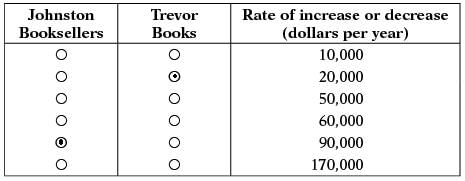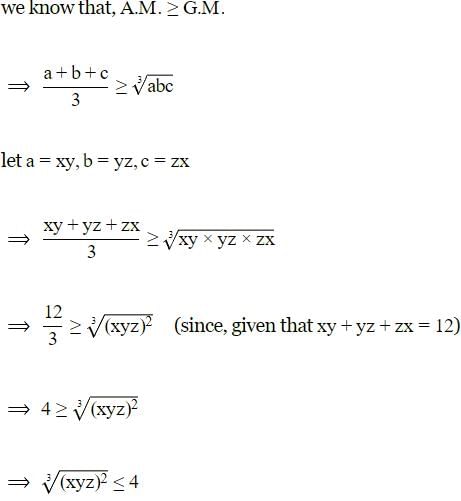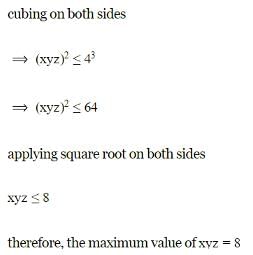Executive Assessment Mock Test - 6 - GMAT MCQ
30 Questions MCQ Test - Executive Assessment Mock Test - 6
E-mail 1—E-mail from marketing director to research associate November 12, 1:15 p.m.
What was our return on investment last year from ads placed in various media? I am developing our marketing budget for next year and would like to determine whether Internet advertising should be continued as extensively as we have in past years. Also, are there data to show how returns from various advertising campaigns differ from quarter to quarter?
E-mail 2—E-mail from research associate in response to marketing director’s November 12, 1:15 p.m. message November 12, 1:35 p.m.
Attached is a graph that shows the return on investment from last year’s advertising campaigns. Typically we do not repeat campaigns in media that return less than 20 percent in any quarter. The return on investment for Internet ads was strong throughout the year, which supports continuing Internet advertising as we have in the past.
Graph 1—Attached to the research associate’s November 12, 1:35 p.m. message
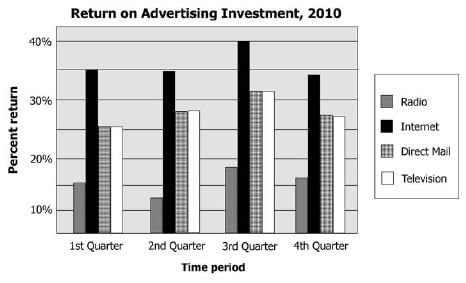
Q. Consider each of the following statements. Does the information in the three sources support the inference as stated?
The research associate does not believe that the 2010 advertising campaign was successful as a whole.
What was our return on investment last year from ads placed in various media? I am developing our marketing budget for next year and would like to determine whether Internet advertising should be continued as extensively as we have in past years. Also, are there data to show how returns from various advertising campaigns differ from quarter to quarter?
E-mail 2—E-mail from research associate in response to marketing director’s November 12, 1:15 p.m. message November 12, 1:35 p.m.
Attached is a graph that shows the return on investment from last year’s advertising campaigns. Typically we do not repeat campaigns in media that return less than 20 percent in any quarter. The return on investment for Internet ads was strong throughout the year, which supports continuing Internet advertising as we have in the past.
Graph 1—Attached to the research associate’s November 12, 1:35 p.m. message

E-mail 1—E-mail from marketing director to research associate November 12, 1:15 p.m.
What was our return on investment last year from ads placed in various media? I am developing our marketing budget for next year and would like to determine whether Internet advertising should be continued as extensively as we have in past years. Also, are there data to show how returns from various advertising campaigns differ from quarter to quarter?
E-mail 2—E-mail from research associate in response to marketing director’s November 12, 1:15 p.m. message November 12, 1:35 p.m.
Attached is a graph that shows the return on investment from last year’s advertising campaigns. Typically we do not repeat campaigns in media that return less than 20 percent in any quarter. The return on investment for Internet ads was strong throughout the year, which supports continuing Internet advertising as we have in the past.
Graph 1—Attached to the research associate’s November 12, 1:35 p.m. message
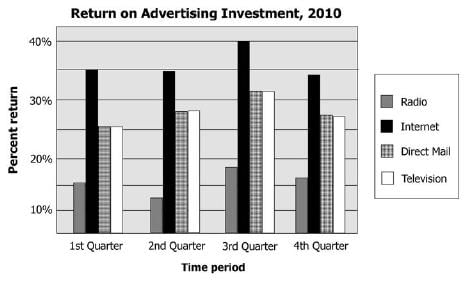
Q. Consider each of the following statements. Does the information in the three sources support the inference as stated?
To increase total advertising returns, the company’s Internet campaign might be expanded during 3rd quarter 2011.
What was our return on investment last year from ads placed in various media? I am developing our marketing budget for next year and would like to determine whether Internet advertising should be continued as extensively as we have in past years. Also, are there data to show how returns from various advertising campaigns differ from quarter to quarter?
E-mail 2—E-mail from research associate in response to marketing director’s November 12, 1:15 p.m. message November 12, 1:35 p.m.
Attached is a graph that shows the return on investment from last year’s advertising campaigns. Typically we do not repeat campaigns in media that return less than 20 percent in any quarter. The return on investment for Internet ads was strong throughout the year, which supports continuing Internet advertising as we have in the past.
Graph 1—Attached to the research associate’s November 12, 1:35 p.m. message

E-mail 1—E-mail from marketing director to research associate November 12, 1:15 p.m.
What was our return on investment last year from ads placed in various media? I am developing our marketing budget for next year and would like to determine whether Internet advertising should be continued as extensively as we have in past years. Also, are there data to show how returns from various advertising campaigns differ from quarter to quarter?
E-mail 2—E-mail from research associate in response to marketing director’s November 12, 1:15 p.m. message November 12, 1:35 p.m.
Attached is a graph that shows the return on investment from last year’s advertising campaigns. Typically we do not repeat campaigns in media that return less than 20 percent in any quarter. The return on investment for Internet ads was strong throughout the year, which supports continuing Internet advertising as we have in the past.
Graph 1—Attached to the research associate’s November 12, 1:35 p.m. message
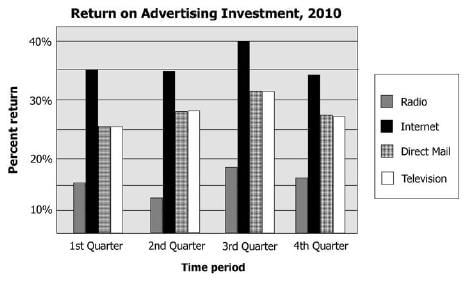
Q. Consider each of the following statements. Does the information in the three sources support the inference as stated?
Based on the company’s typical practices, radio advertising should be discontinued in 2011.
What was our return on investment last year from ads placed in various media? I am developing our marketing budget for next year and would like to determine whether Internet advertising should be continued as extensively as we have in past years. Also, are there data to show how returns from various advertising campaigns differ from quarter to quarter?
E-mail 2—E-mail from research associate in response to marketing director’s November 12, 1:15 p.m. message November 12, 1:35 p.m.
Attached is a graph that shows the return on investment from last year’s advertising campaigns. Typically we do not repeat campaigns in media that return less than 20 percent in any quarter. The return on investment for Internet ads was strong throughout the year, which supports continuing Internet advertising as we have in the past.
Graph 1—Attached to the research associate’s November 12, 1:35 p.m. message


This table provides the standard interest rates offered by Central Bank for CDs, listed according to term offering and purchase amount. The interest rates listed are annual rates, compounded yearly, to be paid when the CD comes to term. No bonuses or other adjustments are included.
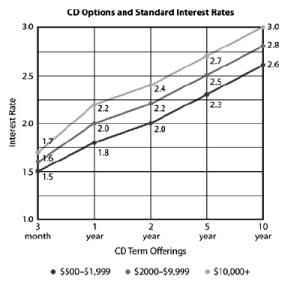

General memo to employees of Central Bank: January 15th In order to improve and stabilize our bank’s investment opportunities, we are seeking to shift the balance of our customers’ CD accounts towards those with longer maturity terms. We have begun testing two incentive programs. All CDs purchased with terms of at least 5 years now receive, as a bonus, an additional 0.1% interest during the first year to be added to the standard rate. Preferred customers (those who have previously bought CDs of any term length in amounts of $10,000 or more) will, when they purchase a 5-year or 10-year CD of $10,000 or more, instead receive a bonus of 0.2% during the first year. Other CDs continue at the standard rates.
We have also instituted a new system of early withdrawal penalties, applicable to all new CDs. The penalties are as follows: For any CD, early withdrawal less than a year after the CD is purchased results in a loss of all interest. For 2-year CDs, early withdrawal after the first year results in the loss of one year of interest. For 5-year and 10-year CDs, withdrawal after the first year results in the loss of two years of interest and of any accrued bonus interest.
Q. Determine whether each of the following investments will earn at least $250 of interest in its first year.
$11,000 invested by a new customer in a 1-year CD

This table provides the standard interest rates offered by Central Bank for CDs, listed according to term offering and purchase amount. The interest rates listed are annual rates, compounded yearly, to be paid when the CD comes to term. No bonuses or other adjustments are included.
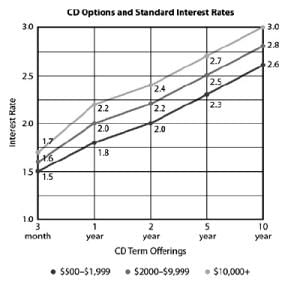

General memo to employees of Central Bank: January 15th In order to improve and stabilize our bank’s investment opportunities, we are seeking to shift the balance of our customers’ CD accounts towards those with longer maturity terms. We have begun testing two incentive programs. All CDs purchased with terms of at least 5 years now receive, as a bonus, an additional 0.1% interest during the first year to be added to the standard rate. Preferred customers (those who have previously bought CDs of any term length in amounts of $10,000 or more) will, when they purchase a 5-year or 10-year CD of $10,000 or more, instead receive a bonus of 0.2% during the first year. Other CDs continue at the standard rates.
We have also instituted a new system of early withdrawal penalties, applicable to all new CDs. The penalties are as follows: For any CD, early withdrawal less than a year after the CD is purchased results in a loss of all interest. For 2-year CDs, early withdrawal after the first year results in the loss of one year of interest. For 5-year and 10-year CDs, withdrawal after the first year results in the loss of two years of interest and of any accrued bonus interest.
Q. Determine whether each of the following investments will earn at least $250 of interest in its first year.
$9,500 invested by a preferred customer in a 5-year CD

This table provides the standard interest rates offered by Central Bank for CDs, listed according to term offering and purchase amount. The interest rates listed are annual rates, compounded yearly, to be paid when the CD comes to term. No bonuses or other adjustments are included.
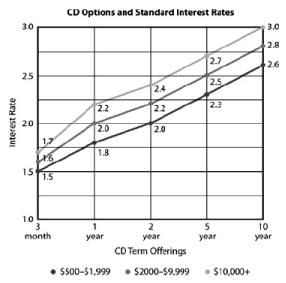

General memo to employees of Central Bank: January 15th In order to improve and stabilize our bank’s investment opportunities, we are seeking to shift the balance of our customers’ CD accounts towards those with longer maturity terms. We have begun testing two incentive programs. All CDs purchased with terms of at least 5 years now receive, as a bonus, an additional 0.1% interest during the first year to be added to the standard rate. Preferred customers (those who have previously bought CDs of any term length in amounts of $10,000 or more) will, when they purchase a 5-year or 10-year CD of $10,000 or more, instead receive a bonus of 0.2% during the first year. Other CDs continue at the standard rates.
We have also instituted a new system of early withdrawal penalties, applicable to all new CDs. The penalties are as follows: For any CD, early withdrawal less than a year after the CD is purchased results in a loss of all interest. For 2-year CDs, early withdrawal after the first year results in the loss of one year of interest. For 5-year and 10-year CDs, withdrawal after the first year results in the loss of two years of interest and of any accrued bonus interest.
Q. Determine whether each of the following investments will earn at least $250 of interest in its first year.
$9,500 invested by a new customer in a 10-year CD
Johnston Booksellers currently generates $50,000 in annual sales revenue. Its competitor, Trevor Books, currently generates $490,000 in annual sales revenue. The sales revenue generated by Johnston Booksellers is increasing each year at a constant rate, while the sales revenue generated by Trevor Books is decreasing each year at a constant rate. If Johnston continues to generate an increased amount of revenue annually at its constant rate and Trevor continues to generate a decreased amount of revenue annually at its constant rate, in four years the bookstores will earn the same amount of annual sales revenue. After the four-year mark, Johnston Booksellers will receive more sales revenue per year than Trevor Books.
In the table below, identify the rates of increase or decrease, in annual revenue earned, for each bookstore that together meet the revenue forecasts described above. Select only one option in each column.
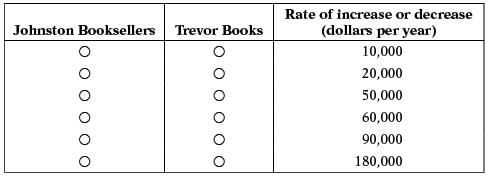
The table below shows the sales, profits, and number of employees for three departments (X, Y, and Z) of a company in 2023 and 2024. All sales and profits are in millions of dollars ($M).
| Year | Department | Sales ($M) | Profits ($M) | Employees |
|---|---|---|---|---|
| 2023 | X | 50 | 5 | 50 |
| 2023 | Y | 30 | 3 | 30 |
| 2023 | Z | 20 | 2 | 20 |
| 2024 | X | 55 | 5.5 | 50 |
| 2024 | Y | 33 | 3.6 | 30 |
| 2024 | Z | 22 | 2.2 | 20 |
Which department had the greatest increase in profit per employee from 2023 to 2024?
The table below shows the production costs and units produced for two factories (Factory X and Factory Y) over two months.
| Month | Factory | Units Produced | Total Cost ($K) |
|---|---|---|---|
| January | X | 500 | 100 |
| January | Y | 600 | 120 |
| February | X | 550 | 105 |
| February | Y | 650 | 125 |
Which factory had the largest decrease in cost per unit from January to February?
Directions: Read the passage carefully and answer the question as follow.
Although websites such as Facebook and MySpace experienced exponential growth during the middle of the first decade of the 21st century, some users remain oblivious to the fact that the information they post online can come back to haunt them. First, employers can monitor employees who maintain a blog, photo diary, or website. Employers can look for controversial employee opinions, sensitive information disclosures, or wildly inappropriate conduct. For example, a North Carolina newspaper fired one of its features writers after she created a blog on which she anonymously wrote about the idiosyncrasies of her job and coworkers.
The second unintended use of information from social networking websites is employers who check on prospective employees. A June 11, 2006 New York Times article reported that many companies recruiting on college campuses use search engines and social networking websites such as MySpace, Xanga, and Facebook to conduct background checks. Although the use of MySpace or Google to scrutinize a student’s background is somewhat unsettling to many undergraduates, the Times noted that the utilization of Facebook is especially shocking to students who believe that Facebook is limited to current students and recent alumni.
Corporate recruiters and prospective employers are not the only people interested in college students’ lives. The third unintended use of social networking websites is college administrators who monitor the Internet—especially Facebook—for student misconduct. For example, a college in Boston’s Back Bay expelled its student Government Association President for joining a Facebook group highly critical of a campus police sergeant. In addition, fifteen students at a state university in North Carolina faced charges in court for underage drinking because of photos that appeared on Facebook.
Although more users of websites such as Facebook are becoming aware of the potential pitfalls of online identities, many regular users still fail to take three basic security precautions. First, only make your information available to a specific list of individuals whom you approve. Second, regularly search for potentially harmful information about yourself that may have been posted by mistake or by a disgruntled former associate. Third, never post blatantly offensive material under your name or on your page as, despite the best precautions, this material will likely make its way to the wider world. By taking these simple steps, members of the digital world can realize the many benefits of e-community without experiencing some of the damaging unintended consequences.
Q. Based upon the passage, the author implies which of the following:
Directions: Read the passage carefully and answer the question as follow.
Although websites such as Facebook and MySpace experienced exponential growth during the middle of the first decade of the 21st century, some users remain oblivious to the fact that the information they post online can come back to haunt them. First, employers can monitor employees who maintain a blog, photo diary, or website. Employers can look for controversial employee opinions, sensitive information disclosures, or wildly inappropriate conduct. For example, a North Carolina newspaper fired one of its features writers after she created a blog on which she anonymously wrote about the idiosyncrasies of her job and coworkers.
The second unintended use of information from social networking websites is employers who check on prospective employees. A June 11, 2006 New York Times article reported that many companies recruiting on college campuses use search engines and social networking websites such as MySpace, Xanga, and Facebook to conduct background checks. Although the use of MySpace or Google to scrutinize a student’s background is somewhat unsettling to many undergraduates, the Times noted that the utilization of Facebook is especially shocking to students who believe that Facebook is limited to current students and recent alumni.
Corporate recruiters and prospective employers are not the only people interested in college students’ lives. The third unintended use of social networking websites is college administrators who monitor the Internet—especially Facebook—for student misconduct. For example, a college in Boston’s Back Bay expelled its student Government Association President for joining a Facebook group highly critical of a campus police sergeant. In addition, fifteen students at a state university in North Carolina faced charges in court for underage drinking because of photos that appeared on Facebook.
Although more users of websites such as Facebook are becoming aware of the potential pitfalls of online identities, many regular users still fail to take three basic security precautions. First, only make your information available to a specific list of individuals whom you approve. Second, regularly search for potentially harmful information about yourself that may have been posted by mistake or by a disgruntled former associate. Third, never post blatantly offensive material under your name or on your page as, despite the best precautions, this material will likely make its way to the wider world. By taking these simple steps, members of the digital world can realize the many benefits of e-community without experiencing some of the damaging unintended consequences.
Q. According to the passage, all of the following represent a possible threat to privacy or an unintended use of data EXCEPT:
Directions: Read the passage carefully and answer the question as follow.
Although websites such as Facebook and MySpace experienced exponential growth during the middle of the first decade of the 21st century, some users remain oblivious to the fact that the information they post online can come back to haunt them. First, employers can monitor employees who maintain a blog, photo diary, or website. Employers can look for controversial employee opinions, sensitive information disclosures, or wildly inappropriate conduct. For example, a North Carolina newspaper fired one of its features writers after she created a blog on which she anonymously wrote about the idiosyncrasies of her job and coworkers.
The second unintended use of information from social networking websites is employers who check on prospective employees. A June 11, 2006 New York Times article reported that many companies recruiting on college campuses use search engines and social networking websites such as MySpace, Xanga, and Facebook to conduct background checks. Although the use of MySpace or Google to scrutinize a student’s background is somewhat unsettling to many undergraduates, the Times noted that the utilization of Facebook is especially shocking to students who believe that Facebook is limited to current students and recent alumni.
Corporate recruiters and prospective employers are not the only people interested in college students’ lives. The third unintended use of social networking websites is college administrators who monitor the Internet—especially Facebook—for student misconduct. For example, a college in Boston’s Back Bay expelled its student Government Association President for joining a Facebook group highly critical of a campus police sergeant. In addition, fifteen students at a state university in North Carolina faced charges in court for underage drinking because of photos that appeared on Facebook.
Although more users of websites such as Facebook are becoming aware of the potential pitfalls of online identities, many regular users still fail to take three basic security precautions. First, only make your information available to a specific list of individuals whom you approve. Second, regularly search for potentially harmful information about yourself that may have been posted by mistake or by a disgruntled former associate. Third, never post blatantly offensive material under your name or on your page as, despite the best precautions, this material will likely make its way to the wider world. By taking these simple steps, members of the digital world can realize the many benefits of e-community without experiencing some of the damaging unintended consequences.
Q. Which of the following best describes the relationship of the fourth paragraph to the remainder of the passage?
Directions: Read the passage carefully and answer the question as follow.
Although websites such as Facebook and MySpace experienced exponential growth during the middle of the first decade of the 21st century, some users remain oblivious to the fact that the information they post online can come back to haunt them. First, employers can monitor employees who maintain a blog, photo diary, or website. Employers can look for controversial employee opinions, sensitive information disclosures, or wildly inappropriate conduct. For example, a North Carolina newspaper fired one of its features writers after she created a blog on which she anonymously wrote about the idiosyncrasies of her job and coworkers.
The second unintended use of information from social networking websites is employers who check on prospective employees. A June 11, 2006 New York Times article reported that many companies recruiting on college campuses use search engines and social networking websites such as MySpace, Xanga, and Facebook to conduct background checks. Although the use of MySpace or Google to scrutinize a student’s background is somewhat unsettling to many undergraduates, the Times noted that the utilization of Facebook is especially shocking to students who believe that Facebook is limited to current students and recent alumni.
Corporate recruiters and prospective employers are not the only people interested in college students’ lives. The third unintended use of social networking websites is college administrators who monitor the Internet—especially Facebook—for student misconduct. For example, a college in Boston’s Back Bay expelled its student Government Association President for joining a Facebook group highly critical of a campus police sergeant. In addition, fifteen students at a state university in North Carolina faced charges in court for underage drinking because of photos that appeared on Facebook.
Although more users of websites such as Facebook are becoming aware of the potential pitfalls of online identities, many regular users still fail to take three basic security precautions. First, only make your information available to a specific list of individuals whom you approve. Second, regularly search for potentially harmful information about yourself that may have been posted by mistake or by a disgruntled former associate. Third, never post blatantly offensive material under your name or on your page as, despite the best precautions, this material will likely make its way to the wider world. By taking these simple steps, members of the digital world can realize the many benefits of e-community without experiencing some of the damaging unintended consequences.
Q. The primary purpose of the passage is to:
Political Commentator: In order for a democracy to flourish, it is essential that political and journalistic freedom of expression exist. Even if commentators voice ideas that do not support the current government, a society is strengthened by the variety of views expressed. Yet, our government continues to exercise a stranglehold on certain forms of speech. It is essential that the government loosen its control on the media. Despite the potential short-term instability this may cause the country, it will strengthen the long-term health of the country.
Q. hich of the following expresses the conclusion of the argument?
For years, a considerable number of students on West County High School's track team complained about shin splints (medial tibial syndrome). However, during the most recent season, the number of students who complained about shin splints dropped significantly. School officials assert that this reduction in complaints occurred entirely as a result of the school's decision to build a new running track that provided a softer running surface, which absorbed much of the shock on the knees and shins that occurs when running and causes shin splints.
Q. Which of the following, if true, most severely weakens the school officials' explanation for the decrease in complaints about shin splints?
As the Federal government's deficit grows, analysts project that the extra cost to the Treasury Department in higher interest rates is well over 50 basis points per year.
Although most large public relations firms can afford to run information technology centers in-house, some niche firms are discovering that the cost associated with maintaining an information technology staff and from continuously improving hardware and software are larger than they initially estimated.
Just as listening to Franklin D. Roosevelt's famous fireside chats helps students of history understand the 1930s, an era marked by incredible domestic economic distress and unparalleled foreign conflict, so Abraham Lincoln's famous Second Inaugural Address helps students grasp the immense strife and challenge America faced in the post-Civil War era.
After a storied investment bank recently fired its CEO and hired an outspoken and flamboyant replacement, members of the news media centered their stories on the replacement's claims that, based upon his past work at a private equity firm, he can return the investment bank to profitability.
A souvenir vendor purchased 1,000 shirts for a special event at a price of $5 each. The vendor sold 600 of the shirts on the day of the event for $12 each and 300 of the shirts in the week following the event for $4 each. The vendor was unable to sell the remaining shirts. What was the vendor's gross profit on the sale of these shirts?
If xy+yz+zx=12, where x,y,z are positive values, then the greatest value of xyz is
To order certain plants from a catalog, it costs $3.00 per plant, plus a 5 percent sales tax, plus $6.95 for shipping and handling regardless of the number of plants ordered. If Company C ordered these plants from the catalog at the total cost of $69.95, how many plants did Company C order?
The value of Maureen's investment portfolio has decreased by 5.8 percent since herinitial investment in the portfolio. If her initial investment was $16,800, what is the current value of the portfolio?
The value of Maureen's investment portfolio hasdecreased by 5.8 percent since herinitial investment in the portfolio. If her initial investment was $16,800, what is the current value of the portfolio?
Company C produces toy trucks at a cost of $5.00 each for the first 100 trucks and $3.50 for each additional truck. If 500 toy trucks were produced by Company C and sold for $10.00 each, what was Company C's gross profit?
The annual profit or loss for the three divisions of Company T for the years 1991 through 1995 are summarized in the table shown, where losses are enclosed in parentheses. For which division and which three consecutive years shown was the division’s profit or loss for the three-year period closest to $0 ?

Did David solve more questions than Steve in a 2-hour test?
(1) Thrice the number of questions that David solved in the test was greater than 6 less than thrice the number of questions that Steve solved in the test.
(2) Twice the number of questions that David solved in the test was greater than 4 less than twice the number of questions that Steve solved in the test.
Each of the 25 books on bookshelf X is thinner than each of the 25 books on bookshelf Y. Is the median thickness of the 50 books less than 20-millimeters?
(1) The thinnest book on bookshelf X is 2 millimeters thick.
(2) The thinnest book on bookshelf Y is 20 millimeters thick.
A box has at least one ball of each of the colors red, green, and blue and no balls of any other color. If one ball is drawn randomly from the box, is the probability that the drawn ball is red same as the probability that the drawn ball is blue but NOT the same as the probability that the drawn ball is green?
(1) There are 5 balls in the box.
(2) The number of green balls is greater than the number of blue balls.
If t and x are integers, what is the value of x?
(1) x2 / t2 = 4 / 9
(2) x > 0 and t > 0



